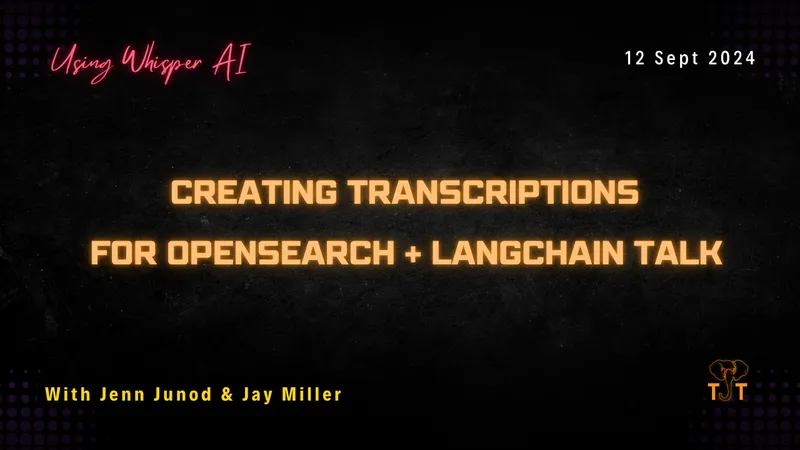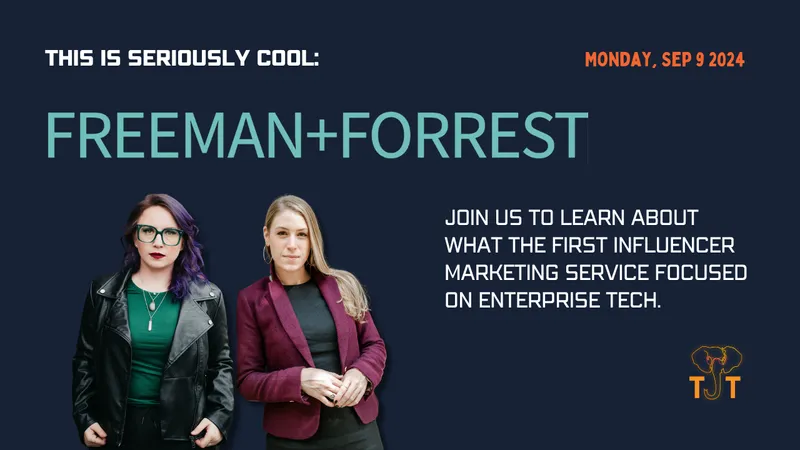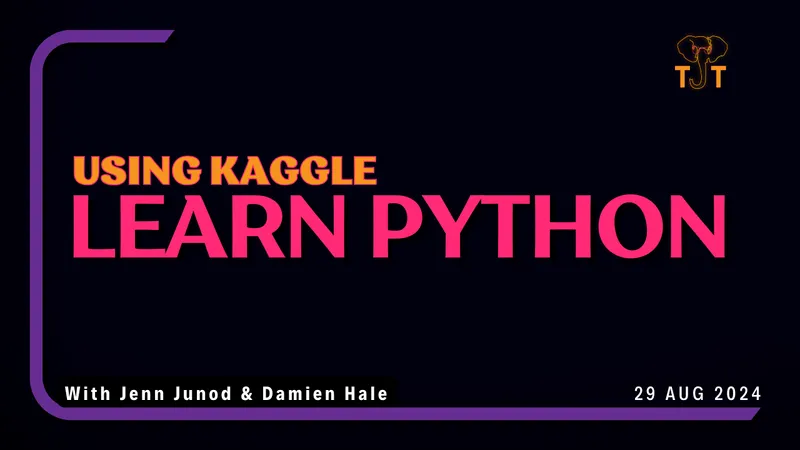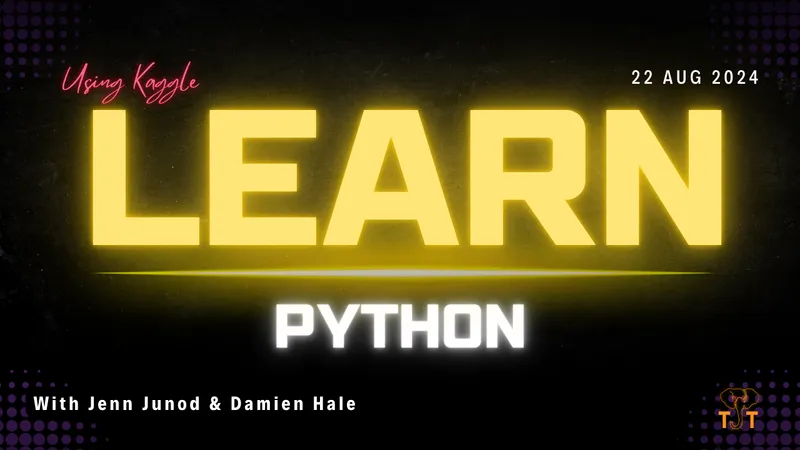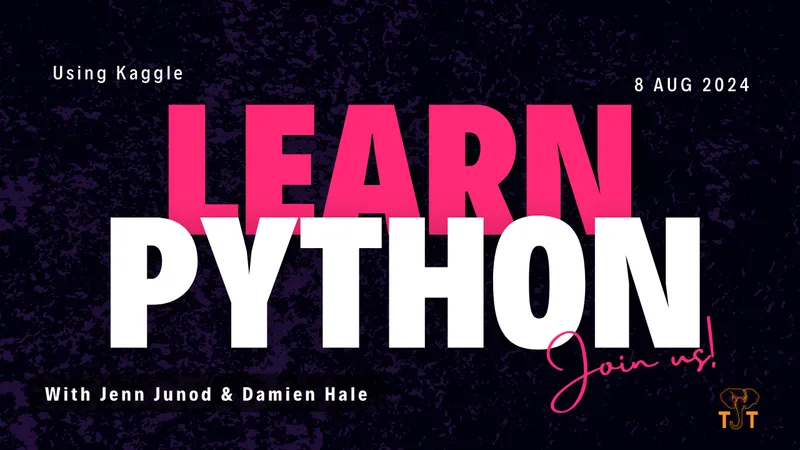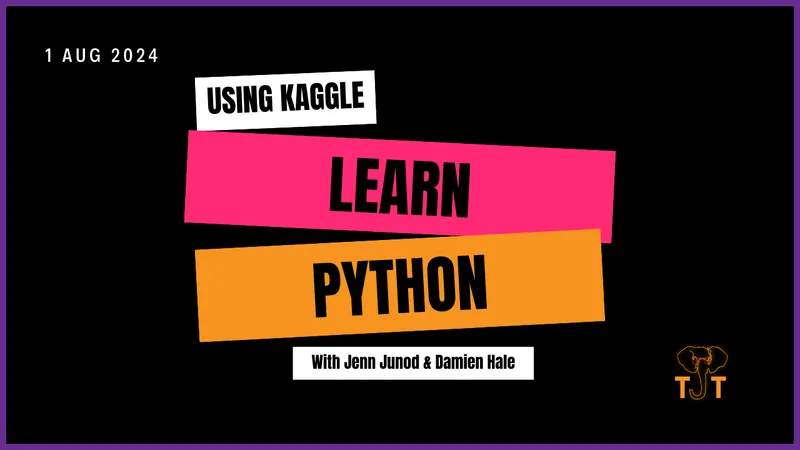Learning about Freeman + Forrest is seriously cool. 😎
Published on 9/9/2024 by Jenn Junod
Written by Jenn Junod
Learning about Freeman + Forrest is seriously cool. 😎
Let’s ask Emily Freeman about how this came about, how it helps influencers and enterprise companies, and what to do if someone wants to get started creating content.
🗓️ Monday, Sep 9, 2024
⏰ 9am PST | 12pm EST
More about Emily & Freeman + Forrest
Transcript
Jenn Junod: Click it. Click it. Click it.
Emily Freeman: We’re live. We’re live.
Jenn Junod: We did it. We did it. Yay. We clicked it. I’m excited. We clicked it. We clicked it.
Emily Freeman: We did the live thing.
Jenn Junod: Yes, we did. We did the live thing. Well, hello, Emily. Welcome to Teach Jenn Tech and also Teach Jenn Content, but that’s what we should call this one. Business, Teach Jenn Business. There’s quite a few that we could be calling this one.
Emily Freeman: I love it. I’m really excited to be here.
Jenn Junod: What would you call it? Would you call it… if you’re teaching people this kind of stuff, would you call it… what would we be learning about today?
Emily Freeman: What would I be learning about today? I think a myriad of topics we will probably cover, including probably a little bit of developer relations because that’s both what we focus on, a little bit of influencer and thought leadership, how to create content and get paid for it, and maybe like a little bit of fun.
Jenn Junod: Yay. Awesome. And to start, who are you, Emily? Who are you? What are you?
Emily Freeman: Yes, I’m Emily Freeman. Here, I’ll do my official intro and then I’ll be me. I’m Emily Freeman. I’m the author of DevOps for Dummies. I’m the co-author of Ninety-Seven Things Every Cloud Engineer Should Know. I left Amazon as their head of community in December, started my own thing with Forrest Brazeal called Freeman & Forrest. It’s an influencer marketing agency. And prior to Amazon, I was at Microsoft. So I have a tech career sprinkled with massive cloud companies.
Jenn Junod: Nice. What up, Jay and Stewart, thank you for… yay, so many more people. Okay, guys, I’m glad more and more people are joining. We are going to be working on, aka me, paying attention to all the chats because we are streaming across four platforms. It is a lot, but I was like, I’m not nervous. It’s fine. It’s Emily, so of course, we had to, you know, make sure people could actually see it and ask questions.
Emily Freeman: Amazing. And please don’t mind my dogs in the background. They’re trapped in the room with me.
Jenn Junod: Wait, why are they trapped in the room? I feel like there’s a story there.
Emily Freeman: My partner is traveling right now, and he’s normally home. He’s the one that handles the dogs while at work, and he is in Denver right now, actually for work. So I need to keep them with me without destroying the house.
Jenn Junod: Oh, I like the nitpicking. Let’s see if my mic is set to the right one. Great call. No, it is not. Thank you for that, Jay. Let’s see where… why is my mic not working? My mic is just gone. That’s cool. Why, Mike? Why? Oh, probably because I moved you. Because technology was a mistake, Jay. What are we doing? Because technology.
Emily Freeman: That is what happens. Technology is sometimes our friend.
Jenn Junod: Oh, we got it. We got it. When it works, it works. When it doesn’t, it doesn’t. Is it better audio?
Emily Freeman: Oh, that’s sweet audio. God damn.
Jenn Junod: Yay. We got the video. Oh my God, that’s true. I was like, oh, now we’re on the radio. Yeah, we got the official mic.
Emily Freeman: Maddie has a really cool mic. Can you teach me your ways when we get off? Because I need… Hi, Tim. I need a better… I mean, we can assess my audio too. Like, I don’t know, maybe I’m terrible at this, but yeah.
Jenn Junod: I feel like that could be something we talk about later on. And y’all, we had a lot of questions for this. So this might be a more than one-part series because there are so many questions. But one thing that… we got the official recap of who you are, but what is the non-turn on the ad version of Emily?
Emily Freeman: I love that. Who is Emily? First and foremost, I’m a mom. I think a lot about… I read an obituary recently. I forget who it was about, but it was all about their career and their contributions to tech. And it’s not that that wasn’t valuable, but I was just overwhelmed with like, that is not what I want my funeral to be about. Let this be the least interesting thing about me. So, yeah, I mean, my daughter Clara is the most important thing to me in the world. I value friendship and human connection above everything else. Tech has been an incredible medium through which I was able to make more and more of those connections. But yeah, I mean, first and foremost, I’m just a person who’s doing their best and sometimes stumbling through life.
Jenn Junod: I feel like we’re all stumbling through life. I would agree with that. There are many times where I’m going, Emily, what am I doing? And info dump—that has been a big part of our calls. Well, thank you for sharing a bit about who you are. Who and what is Freeman & Forrest? It’s a name, so I want to say, who is Freeman & Forrest?
Emily Freeman: Okay, so I’ll go into the company and then the name because the name is so funny and how people react to it. To step all the way back, I left Amazon in December, and I was toast—completely burnt out. We can talk about burnout; that’s its own separate kind of topic that I now am an expert in. But I thought January, I’m going to take a break, write, do all this stuff. You were a firsthand witness to these goals and ambitions. Then my immune system, body, and soul were like, no dog. We’re not going to be doing any of that, Emily. We’re done. So I spent like five months just basically doing nothing. I mean, completely resting. I definitely filled it with activity because I don’t know how to sit still. And that’s a whole other thing around how do you actually sit still in our society? It’s really hard. We’re expected to constantly be moving, doing things, achieving. When you’re not doing anything, it’s like, who are you? What is your value? These are the questions I was going through.
Forrest Brazeal was at Google, kind of in a similar role as I was at Amazon. He left, and we were talking about starting a podcast, which we might do at some point. But we were both helping a few companies with various things, and Forrest was like, I think I have an idea for a company. I’m like, okay, what is it? So he pitches this influencer marketing agency. I’m like, cool, you think people would pay for that? I mean, Forrest founded a company with Chicken Little, and I’m like, I don’t know. Would they? Turns out they do! I should have known better because at companies, we needed to hire content creators, influencers, thought leaders to write or speak on products. The asset would be like a social platform, a newsletter, podcast, or stream.
So yeah, we got started, and it’s been a rocket ship. I’m completely humbled, blown away, shocked, overjoyed, and mildly panicking about how much work we’ve gotten. So at its basic, Freeman & Forrest is an influencer marketing agency. We connect businesses with content creators in tech.
Jenn Junod: Very cool. And part of what Emily and I talk about during our calls is, hey, learn how to do DevRel-y things, and different ways of doing things. And the ADHD overwhelm will happen. I’ll go, hey, I need to do this, and there are so many ways of doing this!
Jenn Junod: And there’s like so many ways of doing this. And I don’t even know how to… weird, I don’t know what, and one thing that Emily has mentioned is how to start breaking down concepts, and y’all are gonna make fun of me for this, but “Learn with Jason Jason,” because I always mess up Jason’s last name. So… oh, Lancer! I’m always like, it’s Jason, Learn with Jason, Jason, Jason. And see, again, I don’t even remember what the phrase is, um, because I think “water buffalo,” but that is also not the phrase.
Emily Freeman: [laughing] I love your brain so much.
Jenn Junod: Because he has this thing about how you break down content and repurpose it multiple times. Again, it’s “Learn with Jason, Jason Water Buffalo.”
Emily Freeman: [laughing]
Jenn Junod: And thank you, Anthony, for saying it’s the “Buffalo Stick,” not the water. Got it! Okay, um, sorry, not sorry, Jason. That’s amazing. And this will forever be the whole “Water Buffalo Stick.” But like, that’s been in my head for so long. And a lot of times for myself, if I’m working on my own content, it’s harder. I get really, really stuck on how to do that.
Emily Freeman: Mmm-hmm.
Jenn Junod: And Emily has been talking about Freeman and Forrest and learning. Something that we got started with when we first started talking was how to do tech talks and taking notes on doing that. And I was like, “Yo, can I ask you all these questions on stream and work on making them into tech talks, and maybe a blog, or see if we can do some water buffalo sticks?”
Emily Freeman: [laughing]
Jenn Junod: And look at us now. Achieving!
Emily Freeman: Yeah, we did it.
Jenn Junod: And yes, I’m going back to a few of the questions because I’m seeing them come in from all the different platforms. Oh, let me talk about the name because I failed to do that.
Emily Freeman: Yes, the name!
Jenn Junod: It sounds… I think most people hear Freeman and Forrest—which, by the way, I had to buy ForrestandFreeman.com, too, because we both messed up the order of this so many times.
Emily Freeman: [laughing]
Jenn Junod: But Freeman and Forrest, it sounds like a lawyer, a law firm, and a county firm. And that’s sort of on purpose, right?
Emily Freeman: [smiling] Yeah.
Jenn Junod: Because one, this shouldn’t be the most exciting part of the process, right? Our job is to make connections and to make sure that the content creators can really shine and that our customers’ products shine. We should be the least interesting thing about this process. And we’re staking our reputations on this, right? I feel so strongly about doing this right and making sure that everyone wins that I’m putting my name on it. I don’t want any customer to think that I’m taking this lightly or doing the bare minimum. Like, my whole reputation is on this, and I’m going to do the very best job I can to represent their brand and protect their brand while also connecting the dots and making sure the community gets the best possible content.
Emily Freeman: I like that.
Jenn Junod: And also, because I’m very stuck on this, how did you come up with Freeman and Forrest? Because it’s your last name and Forrest’s first name. And I just, I don’t know why I found that so funny from the beginning.
Emily Freeman: [laughing] Both Forrest and I prefer alliteration over consistency.
Jenn Junod: [laughing]
Emily Freeman: And so, um, it was like, great! “F and F,” that’s awesome. Ship it. Um, I think for… we thought about doing our first names within it. Honestly, it sounds like a wedding.
Jenn Junod: [laughing]
Emily Freeman: It’s like, “Forrest and Emily,” like… and that is kind of more funny because Forrest’s wife’s name is actually Emily.
Jenn Junod: [laughing] Oh no!
Emily Freeman: But yeah, we go for alliteration above anything else.
Jenn Junod: I love alliteration! That’s awesome.
Emily Freeman: [laughing]
Jenn Junod: AJC Web Dev, who’s in the chat, is one of the first people that was ever on the live stream. And his then-girlfriend, then-fiancée, now wife, her name is Jen.
Emily Freeman: [laughing]
Jenn Junod: So like the very first stream was like, “This is Jen, not my girlfriend Jen.”
Emily Freeman: [laughing] Exactly!
Jenn Junod: Different Jen.
Emily Freeman: Different Jen.
Jenn Junod: Different Jen. And thank you for that. I think something that a lot of people don’t… because the really cool thing about, at least that I’ve seen with my channel, as well as a lot of the people that follow both you and I, is we have two different markets of people that follow us.
Emily Freeman: Right.
Jenn Junod: Okay, there’s probably many more, but the two to focus on are the business decision-makers and then the content creators.
Emily Freeman: Right.
Jenn Junod: And a question that comes to mind is, why would businesses reach out to influencers or content creators? Why not make it in-house? Why is this even a thing, trying to find influencers?
Emily Freeman: I love this question, and it’s so multi-layered. So I will go in no particular order…
Emily Freeman: So I will go in no particular order. One of the challenges I faced both at Microsoft and at Amazon was trying to reach people who were not already bought into the company, right? It’s easy to maintain relationships. Now, companies still mess it up, but generally speaking, it’s a much smaller lift to maintain the relationships with people who are already bought into your product, already fans, already show up at your first-party events, like re:Invent or Build, those company-sponsored conferences. It’s much harder to reach new people because you have to go where they are, right? These people are not already engaged with your properties or your content. So they’re not coming to amazon.com for AWS. I mean, none of us can escape Amazon. They bought my grocery store, and I’m just really upset about it, but it’s fine! That’s a whole other topic.
So you have to reach out to people in different communities and understand how they access information, which is unique based on where they are. They’re consuming newsletters, they’re on social media networks like Twitter (I refuse to call it X), LinkedIn, they’re listening to podcasts, watching streams, or learning on YouTube. When I need to learn something new, YouTube is where I go. I love learning from people who teach me by talking to me. So video works really well for me.
But when you’re at these companies, a lot of times they have developer relations teams, and that’s so important, right? We are not replacing developer relations. I want to be super clear about that. I’ve gotten on calls with folks, and there was a very defensive vibe, and I was like, “I’m not here to replace you.” I’ve spent a decade-plus building Developer Relations into, I hope, a better place than when I started. I’m not looking to end this specialty.
But it’s an addendum. You know this, Jenn. When you’re working in Developer Relations, you are the frontline as far as deep knowledge on your specific products, understanding where they fit in the market, and understanding why customers would use them for a specific reason, connecting those dots. But reaching out beyond our “solar system” is tricky. Like, within my reach, I have a large bubble, but there’s an edge to that bubble. I can’t go beyond it. And I think we all have that limitation. It’s about accelerating our content and reaching new folks. You need those types of external influencers to do that.
Jenn Junod: You brought up a great sub-question: what’s the difference between Developer Relations and influencers? Because if it’s not to replace developer advocates, which, as you know, means different things to different companies and roles, what would you say the biggest difference is between the two?
Emily Freeman: Yeah, and there’s definitely a Venn diagram—Kamala Harris style! I love a Venn diagram. You have to look at the overlap. The biggest difference is the anchoring of your day-to-day job. When I was at Microsoft, I focused mostly on Azure DevOps and infrastructure as code, helping people understand how they could use Azure for that purpose. But I had never used Azure DevOps outside of my employment at Microsoft, and I would say that’s relatively common for DevRel roles. You get a role, you learn the product, and go from there.
Obviously, there’s a skill set before that, and you have to be able to connect with people. But there’s that connection back to the company branding. Anytime you work at a company, there are limits to what you can say within your employment. In my experience, there was more power in Developer Relations to push back on leadership and product teams to protect communities. But over time, I felt that power waning.
For me, the primary difference is that when you work in DevRel, you are the technical expert on your product, expanding beyond your reach and the reach of your team. Once you’re bought into a product, you hit the edge of your audience pretty quickly. External influencers, however, can promote the content that DevRel teams are doing, extending the feedback loop and helping you connect with developers and technical audiences beyond those bubbles.
Jenn Junod: That makes sense. A basic recap would be: DevRel, when they work for a company, shows how you make content work better for that product. But an influencer might say, “Hey, this is how you make this product work with a different product, or how they work together in an ecosystem.”
Emily Freeman: Yes, exactly! You get different perspectives. Even in my current role, I’m more energized about tech than I’ve been in five years because I know more about what’s going on in the broader industry. When you’re inside huge companies like Microsoft or Amazon, it’s hard to see beyond the silos. But now, I get to hear from startups doing some really cool stuff, and it makes me excited again. It feels great!
Jenn Junod: Yay! That’s awesome to hear because sometimes it can feel like we’re stuck in the loop of negativity, so hearing the positive side is refreshing.
Emily Freeman: For sure.
Jenn Junod: So, how do you find influencers? And how do you match them to companies?
Emily Freeman: That’s the magic! We focus on connecting companies with audiences and communities aligned to their niche, technical focus, and use case. We look for high-impact, high-value impressions. By that, I mean, we want to make placements where the audience is going to be genuinely interested in the product, use it, or purchase it. You can get high reach by blanketing a bunch of podcasts and newsletters, but some of those newsletters have big numbers but zero-calorie impressions—they don’t do anything for the company.
We find influencers who are subject matter experts in specific areas, who learn in public, and who create or speak about content. We reach out to influencers who fit that niche and work with them. Size matters, of course, but it’s not everything. We work with tiny newsletters that have really engaged audiences, and that’s where we find the real value.
We don’t just blanket the space. We think carefully about who the best influencer is for the product. We also make sure the influencer feels comfortable with the company and product. For example, Diversify Tech vets every company to ensure it aligns with their values around ethical employment. If they’re not comfortable, we don’t move forward.
Jenn Junod: You’re great at leading into other questions! Earlier, you mentioned zero-calorie impressions. How do you measure that?
Emily Freeman: It depends on the campaign. Typically, there are three styles of engagement. One is an awareness campaign or brand lift—just getting people to know you exist. The second is an engagement campaign, which is less popular now but was more so in the past, where you focus on likes, reposts, comments, and getting people to engage with your content. The third, and most popular now, is driving toward a sales goal, focusing on click-through rates.
Jenn Junod: [laughing] Time out. Campaigns always remind me of D&D or video games!
Emily Freeman: [laughing] Totally! But in marketing, campaigns are focused strategies for a specific goal, like brand awareness. You might name it “Freeman and Forrest 2025” and track numbers for that campaign over the year, breaking it down per quarter or project.
When we talk about awareness campaigns, it’s often for companies trying to enter the U.S. market, for example. We work with amazing companies from Europe and Latin America who want to reach U.S. developers. Engagement campaigns get people to interact with your brand, while the click-through campaigns focus on newsletters or LinkedIn because those channels are great for driving click-through rates.
Jenn Junod: But what about AI campaigns?
Emily Freeman: [laughing] Complicated feelings there! AI is super exciting, but a lot of the hype is salesy noise. I’m more interested in AI products that genuinely improve developers’ lives and are responsible. What’s the point of AI if it burns down the planet?
Jenn Junod: [laughing] Thank you! Let’s put a pin in that for now.
Jenn Junod: I’m going to put a pin in that one because I want to focus on the content creators for a bit. Rachel asked a great question that works as a segue: “Do you consider this a two-sided market? If so, how do you approach outreach for both content creators and businesses?” You’ve mentioned earlier that you want to see influencers grow as well as their audiences. How do you support both sides at the same time?
Emily Freeman: Yes, this is probably the hardest part of the company. It absolutely is a two-sided market. To explain that, think of Netflix. Netflix exists in a two-sided market—they make deals with studios that produce media, put that content on their platform, and then sell it to customers on the other side. A one-sided market would be something like selling concealer directly to a consumer.
For us, we negotiate with both customers and clients to tailor influencer campaigns to specific needs. We have default options that are ready to execute, but we can also create custom proposals. Some companies don’t care about clicks—they need custom content because they might not have developer relations resources in-house anymore. Some companies even cut their entire DevRel teams, so they’re in a lurch and need support. We negotiate what we provide to the clients and the cost, but the same goes for the influencers.
Not all influencers are at the same stage. Someone with a newsletter that reaches a million people will command a higher price than someone who reaches six thousand. It’s important to check with influencers to ensure they’re comfortable with the brand—does this company align with your values? Do you feel like you can speak to the product with integrity?
My greatest goal is to grow content creators. A lot of influencers are currently working for free on the weekends, creating valuable content that we all use. Being able to pay them for their time makes me feel so good! Eventually, I want to be able to say we pay influencers millions of dollars a year to create this content. That would be the ultimate outcome.
Jenn Junod: I love that! And I know we only have about 15 minutes left, but this is a great segue to the next question: “What does a good candidate client look like?” And JT also asked, “Is professional editing, intros, etc., required, or can a seat-of-their-pants podcast make sense?”
Emily Freeman: If I understand the question correctly, it’s asking what makes a good influencer—do they have to be super polished, or can they be more ad hoc?
The answer is, it depends. The most high-value influencer assets right now are newsletters and LinkedIn followings. They perform the best in terms of impressions and click-throughs. The format works well because newsletters let you click immediately, and LinkedIn has a great algorithm for long-tail content that resurfaces over time. If you have a big LinkedIn following, that’s incredibly valuable.
Right now, podcasts are the least interesting for driving click-through rates or tracking, though they do work for brand awareness. Clients can be hesitant about podcasts because it’s harder to directly track success. Some clients also have reservations about influencers in general, especially in tech, because they don’t want to seem too salesy. But that’s where the balance comes in—DevRel exists because developers are allergic to sales. So influencer marketing in tech is more about raising awareness and giving people the information they need rather than pushing a hard sale.
Sponsored content is very common, and the FTC has strict rules about how partnerships should be disclosed. We make sure everything is transparent because it’s important to both Forrest and me. There’s no shame in paid partnerships. It’s the same as paying open-source maintainers for their time—content creation is just as valuable.
Jenn Junod: Great insights. And now, a question that I think will lead nicely into a future discussion: “What are the best foundations for content creators at different stages—amateur, established, and accomplished?”
Emily Freeman: Becoming an influencer is fascinating. I ended up building a Twitter following by accident because I call myself “jalapeno spicy.” You want to be interesting enough to stand out but not so spicy that you burn everyone out. Right now, I see people mimicking controversial influencers who blew up fast, but I don’t believe that’s sustainable.
For me, I don’t like working with or consuming content from people who are mean-spirited or cut others down. That behavior might get attention now because algorithms reward controversy, but I don’t think those influencers will have long careers. They might have a moment, but they flame out.
There’s also the “perfect” influencer model, like the Ballerina Farms account, which focuses on portraying an impossibly perfect life. That content appeals to a certain audience, but it doesn’t foster real trust or connection. It’s very one-sided and not intimate.
What makes long-term influencers and thought leaders stand out is when they showcase their struggles, mistakes, and realness. That’s what people can bond with. I encourage everyone to be true to themselves. The accidental strategy I took was just being myself on Twitter. It’s not my whole self, but it’s an authentic part of me. I curse in real life, I’m funny, I’m opinionated, and I make mistakes. That’s what resonates with my audience.
When you’re building content, don’t mimic what you see. Speak in your voice, from your experience, and that will carry you. Learn out loud, make mistakes, say you’re sorry, have successes, highlight others. It’s not just about you—it’s about how we all fit into this broader community. That’s where you shine.
Jenn Junod: That’s such great advice. I have so many more questions, but we’re out of time! I’ve posted where people can find the recording, and I’ll share the transcript and key questions later. To close, what advice would you leave the audience with—whether for content creators, businesses, or just as humans?
Emily Freeman: Get started. I’m going to run out of influencers to place with before I run out of companies willing to sponsor them. I need to give you money! The best advice is to start a newsletter, cross-post to Twitter, LinkedIn, etc. The influencers who command the highest prices are the ones who sell it all as a package. We all have limited time, but I highly recommend starting with a newsletter as your lead asset. Then drive attention to it by being authentic and speaking with your own voice.
Jenn Junod: Thanks for that! The link to Freeman & Forrest is on the site I sent out, along with where to follow Emily. Thank you all for joining us today! We’ll schedule the next one soon. Have a wonderful day!
Emily Freeman: Thank you for having me, Jenn.
← Back to content